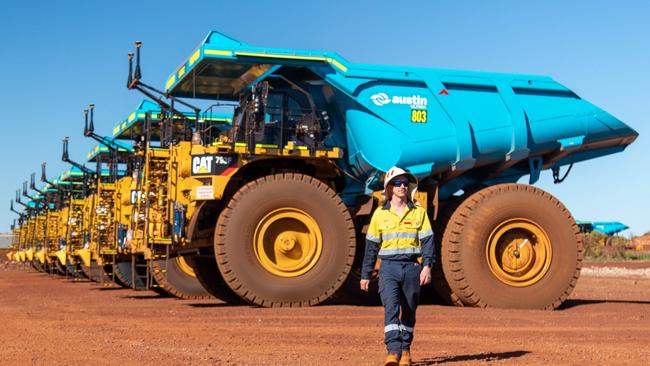Rio Tinto, Caterpillar to bring clean autonomous trucks to Gudai-Darri in WA
Rio Tinto’s new Gudai-Darri mine in WA will become a testbed for some of the cleanest autonomous haul trucks in the world.

A new generation of autonomous haul trucks boasting zero-emissions technology will be put to work at Rio Tinto’s new Gudai-Darri mine in WA in the next few years.
More than a decade after pioneering the use of autonomous trucks at its mines, Rio Tinto on Wednesday signed a memorandum of understanding with manufacturing giant Caterpillar to develop the 220-tonne 793 zero-emissions autonomous haul truck.
Rio Tinto and Caterpillar will progress a series of development milestones to include a 793 prototype pilot program, testing and pre-production trials.
It is anticipated that the world’s first operational deployment of approximately 35 new Caterpillar 793 zero-emissions autonomous haul trucks will be at Gudai-Darri once development is complete.
The under-construction $3.6bn Gudai-Darri project is Rio Tinto’s most technically advanced iron ore mine, in the Pilbara, WA.
Rio Tinto’s chief commercial officer Alf Barrios said the group’s ambition was to reach net zero emissions across operations.
“Reaching this ambition will require new and innovative solutions and partnerships with supplier partners like Caterpillar.
“This collaboration represents a small but important step on that journey.”
Validation of Caterpillar’s zero-emissions haul trucks technology is likely to take a few years.
Caterpillar Group president Denise Johnson said Rio Tinto can more safely increase productivity, efficiency and be more sustainable through the integration of autonomy with a zero-emissions fleet across sites.
“We are pleased to be part of Rio Tinto’s sustainability journey and look forward to building on our longstanding collaboration.”
In June, Rio Tinto said it would deploy the world’s first fully autonomous water truck at Gudai-Darri, which will also be produced by Caterpillar.
Rio Tinto operates 250 autonomous haul trucks across nine mine sites in WA after first trialling them in 2008.
The trucks are monitored through a supervisory system and a central controller, rather than a driver and are used on predefined GPS courses while processing information on actual locations, speeds and directions of other vehicles at all times.
BHP and Caterpillar announced a similar partnership last month for driver-operated zero-emissions trucks.


To join the conversation, please log in. Don't have an account? Register
Join the conversation, you are commenting as Logout